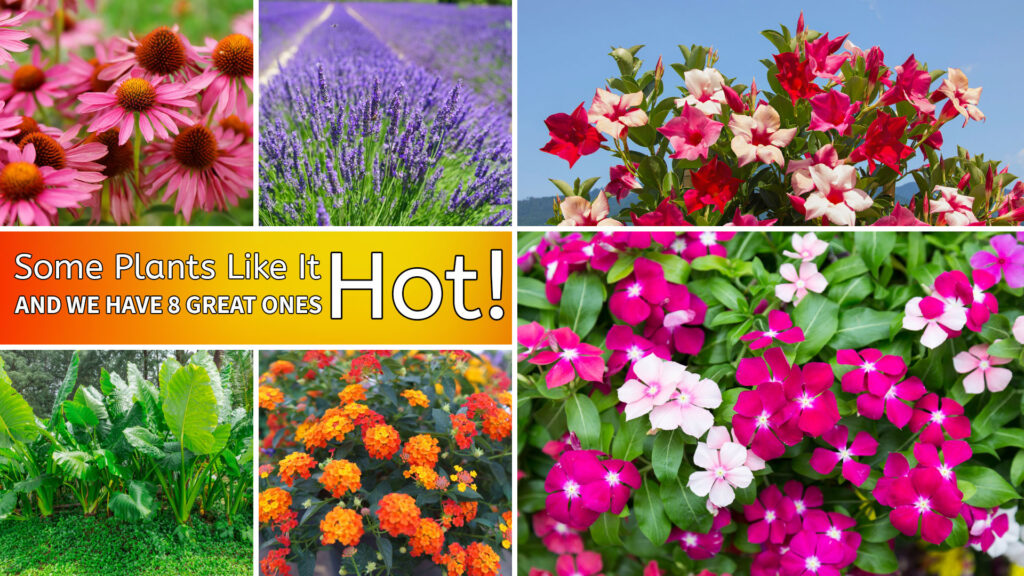
As the summer heat continues its hold over our area, you may notice some of your spring plantings beginning to wilt, droop, and look sad. Unfortunately, many plants cannot handle the intense heat of our summers. Fortunately, there are many plants that not only tolerate but love the hot weather. Below are eight different plants that you can find right now at your local Meadows Farms nursery.
Flowering Vinca
Flowering vinca is one of the premier flowering bedding plants for sunny, hot areas. Vinca is drought-tolerant and can thrive in any soil provided that it is well-draining. Vince is also a low-maintenance plant, so they are perfect for the gardener who does not have a lot of time to spend in the garden. Vince comes in many shades of pinks, mauves, and whites and blooms abundantly throughout the summer.
Lantana
Lantana is a showy, drought-tolerant woody annual with clusters of beautiful flowers that come in mixed shades of yellow, orange, red, pink, and purple. They work well in borders or mass plantings, and their trailing habit makes them prime candidates for hanging baskets or your favorite patio container. Lantana loves the heat, so plant them in well-draining soil and keep them watered regularly during the hottest days.
Lavender
If the soothing fragrance isn’t enough to convince you of the value of lavender in the landscape, perhaps its ease of maintenance will. Hardy perennial lavender is easy to grow and thrives in high heat conditions provided you plant it in well-draining soil. Because of the scent, lavender is also quite pest-resistant, and its blooms are a perfect attraction for pollinators like honey bees and butterflies.
Tropical Hibiscus & Mandevilla
Transform your patio into an oasis of color by adding pots of blooming tropical annuals like Hibiscus or Mandevilla vines. Fill a few ceramic pots with several of these blooming beauties and your patio will become an outdoor living room. These tropicals love the hot sun, but make sure they get ample water to keep them looking their best. We carry each in an array of colors which will provide an incredible show from now until the cold nights of October.
Ornamental Grasses
Ornamental grasses are available in a wide array of colors, shapes, textures, and sizes. The flowers and subsequent seed heads are equally diverse, ranging from “ho-hum” to genuinely spectacular. Most ornamental grasses thrive in the hot, full sun. Many varieties are quite drought-tolerant, though a few can handle wet areas as well. Their adaptability and subtle beauty make them perfect companions to flowering plants and other woody ornamentals.
Coneflowers
Coneflowers are a native perennial to North America and have been a staple plant dating as far back as the Native Americans. However, it wasn’t until recently that coneflowers have been making a resurgence in home gardens. Once only pale pink, coneflowers are now available in a multitude of different varieties that provide a summer seasons’ worth of color year after year. They are also great plants to attract pollinators. Bees, butterflies, and birds love hanging around the large blooms.
Elephant Ears
Native to the warm and humid climate of tropical Southeast Asia, elephant ears are a showstopper in the garden. Varieties of elephant ears can reach anywhere from 6 to 10 feet in height, with massive sized leaves that give them their name. While Elephant Ears enjoy the hot and humid weather from our summers, they don’t enjoy direct sunlight. A shaded area or one that contains filtered sunlight is an ideal place to plant them.
SunPatiens
Have you ever wanted the elegant beauty of flowering impatiens or New Guinea impatiens, but the sun in your garden makes it impossible? SunPatiens are for you! SunPatiens have the same look of classic New Guinea impatiens but are grown with stronger foliage and thicker bloom petals to withstand high heat, sun, and disease. They make a great addition to any summer flower bed.


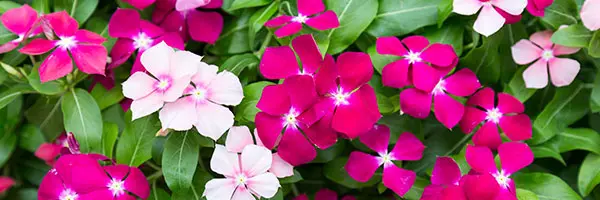
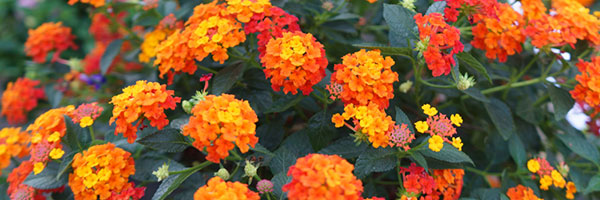
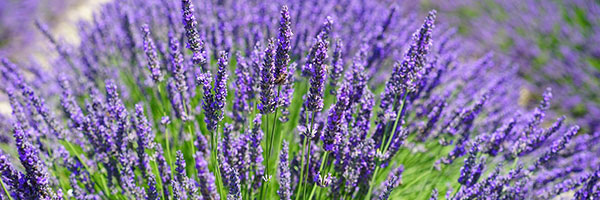
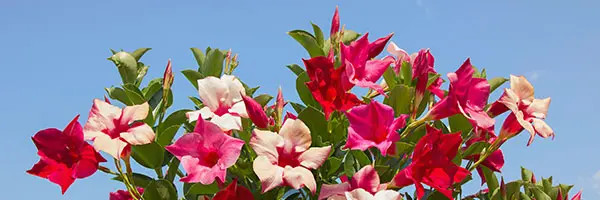
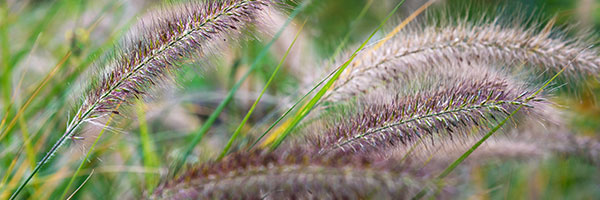
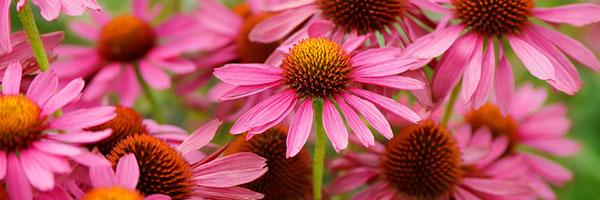
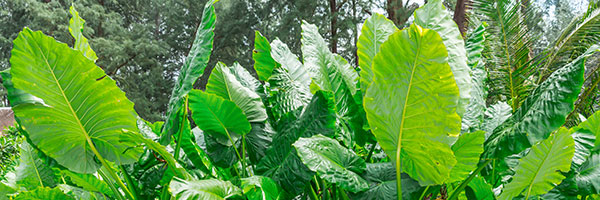
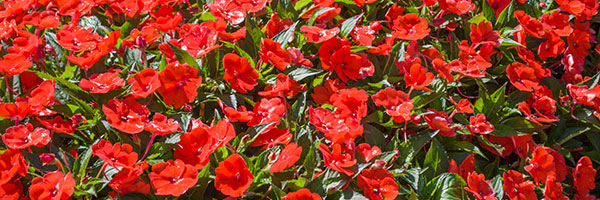
great information – both flowering vinca and sunpatients have been outstanding in the sun. They are strong and vigorous. New Guinea impatients are so much weaker. THANKS
I also love sunpatiens.. but this year they were attacked by pests/fungus and they are very water intensive. You can’t miss a day or they wilt!
I love lavender, but have not had much luck with it. I have tried to plant it in a pot and in the flower bed, but it did not make it either. Any ideas?
I’ve struggled with lavender myself over the years, and I found that I was getting it too much water. Lavender tends to like to dry out quite a bit, and any conditions where it might be sitting in moisture for extended periods can be troublesome. If you do try to plant it again, make sure that it is in a very sunny area (6 to 8 hours) where water doesn’t collect. If you plant them in pots, let the soil dry out a bit in between waterings.
I have found that it is important to harvest/prune lavender while harvesting. This makes the plant more vigorous. With a lavender scythe, grab a bunch of flowers/stems in one hand while cutting the stems about one inch below the new growth with the scythe
A sunny location and sparse watering are preferable. Bonus: The deer won’t eat lavender!
Like your articles and helpful info –
Thank you, Ellen.
I love the sunpatients however – everywhere ive read and everything ive been told is that they dont need a lot of water hence the reason they are so tolerant of the heat however i water them and they die!!!! just like that.. lost my patients is what they should be called.
I have planted vincas here in the mid-Atlantic (6B) and more south, in USDA hardiness zone 7B. They are great in hot, dry flowerbeds. My experience has been that you should not plant them before May because, if you do, the cold weather stunts their later growth and they don’t flower out as fully.
I would also add nasturtiums to the list of plants that like it hot, noting that in this location, my nasturtiums have always attracted bugs once they are mature and their stems are starting to get leggy.
Nasturtiums are a good addition, Lisa. I’ve always had the bug and legginess problems that you mention, so I’ve tended to avoid them, but they are great for those extra hot and sunny areas.
My favorite annuals are petunias, but they are all dying from the heat. Growing up in the 60s we never had this problem. I’m going to replace all the petunias with vinca. Hope you’ve got lots of them!
We sure do! They’ll make a great replacement. 🙂
Mike watch this – https://www.youtube.com/watch?v=_1bX6W4bI8w
ill never plant the lobelias in hanging baskets
I have been disappointed for 3 years w/my hydrangea bushes, no flowers but lots of beautiful leaves. When should I prune them?
It depends on what variety of hydrangea you have, as certain types can bloom on old wood or new wood. A good rule is if it’s a blue hydrangea, it’s best to prune it in the summer right after they’ve finished blooming. If your hydrangea is a newer variety such as Limelight or one of the “snowball” hydrangeas like Annabelle, you should prune in late winter/early spring before the plant begins growing again.
Thank you for responding. My bill from 10/30/14 , no. 14107223 says I have (2) Endless Summer and (2) Penny Mac. Right now I have 1 blue flower and all leaves. When do I cut them and how far down should I cut?
Penny Macs will bloom on old wood, so they should be pruned soon. Endless Summer blooms on both old and new, so you have a bit of leeway there. I would suggest for both to prune them now, or once your one blue flower begins to fade out. As for how far to cut back, I would prune as much as needed to clean then up and shape them how you see fit. You can even cut out some of the older woody canes to help with better blooming. The hydrangeas will start setting their buds once it gets cooler, so avoid any pruning once September sets in or you will prune off your blooms for next spring.
Thanks again, I hope this works. I’ve been disappointed ever since I bought them. I did no trimming for the past 2 years hoping something would happen but nothing did. I will prune them this week.
I’m looking for a native ornamental grass for full sun. What do you recommend?
If you’re looking for smaller varieties, Carex grasses are great natives that can handle the sun. For larger, more traditional grass varieties, Panicum Shenandoah is a lovely variety, along with Little Bluestem grasses.
I planted a lavender plant last year I believe it’s called Phenomenal, it’s doing well but it’s starting to look a little droppy and sloppy. Should I prune it back and if so what is a good time to do this?
Spring is usually the best time to prune back lavender, but if it’s getting unruly now it’s fine to prune back. It just may not come back as full before the end of the season.
My hydrangeas suffered from heat scorch last summer so I cut them back all the way to the ground. Uh oh. I think I made a huge mistake as they are not blooming at all this summer however they are green and lush! What should I do? Should I prune them or just leave them alone?
Hi, Mary. I would just leave them alone for this season. You most likely have a variety that sets its blooms on old wood, so when you pruned them last year you accidentally pruned this year’s flower buds. It sounds like it’s still healthy and growing, so let it be this year and it should bloom like normal next season.
All of my Knockout Roses (25 bushes) have developed Rosette Disease. I started picking off each “new rosette growth” but with so many plants, I have not been able to keep up with this. I’m not sure if it was doing any good since the new growth was back in a day or two. I’ve heard that the only “cure” for Rosette Disease is to dig up all the bushes and destroy them. I’ve also read that you should not plant new roses where the ones diseased ones grew. I hate to dig up all my once beautiful rose bushes. I thought of cutting them all back to about 10″ but wasn’t sure if this would help. What should I do?? Also, what types of roses are resistant to Rosette Disease?
Hi, Judy. Unfortunately, there is no current treatment for Rosette Disease outside of discarding the plants themselves, and to my knowledge, there are no rose cultivars that are resistant to it. You can certainly cut them back, but I fear that is just a temporary solution and the disease will just manifest again over time. Proven Winners has a good website with information, including a link to send pictures to confirm if it is indeed Rosette: https://www.provenwinners.com/learn/pest-management/what-rose-rosette-disease
If they indeed confirm your suspicions of Rosette Disease, unfortunately, removal may be the only option.
Roses need good air circulation to avoid diseases. The knockouts tend to get dense. So, before you dig them up, try some selective pruning to get air space to the interior. Deadheading spent blooms is also a good idea. Humidity and heat
assist disease. Water the base of the plant in the morning. Don’t get the leaves wet.
I have two different wisteria- amethyst falls and blue moon. I’m not how or when to prune. My amethyst falls has gotten out of control now and needs major pruning.
Thank you!
Renee
Hi, Renee. If you’re looking to clean up an overgrown Wisteria, you’re free to prune back as much as you need to get it under control. However, doing this will prevent blooming for a year or two until new shoots begin to mature. It’s best to prune Wisteria two times a year, once in July/August once the bloom period has ended, and again around midwinter in order to keep it under control. In these cases, you only prune back the season’s new growth each year so that growth stays controlled while encouraging blooms.
I have a hydrangea that I thought was snowflake but is not bright white. It more of a cream color. Do I cut this down halfway in the fall? I’ve never trimmed in the last three years ~ just cut the dead blooms off.
Hi, Kerry. If you want to prune it back to control growth, you can certainly do it, but you’ll run the risk of no blooms next season if you have a variety that blooms on old wood. If you’re happy with the size the hydrangea is at currently, continuing with what you’re doing now is probably best.
What about coreopsis? I thought they were a great late summer plant (and deer resistant) but lately while some varieties have done very well, the pale yellow one with asparagus-like foliage (Moonbeam?) is just toast.
Coreopsis can be a great summer-blooming plant that can thrive in hot conditions, but coreopsis is very susceptible to drought conditions, and with the lack of regular rainfall we’ve experienced this summer some varieties may struggle in the heat without regular, daily soakings.
Mike –
what about creek bed plants? I need to protect my creek bank – and most of it is in shade. What can I plant to build a root system that can handle shade and occasional flooding?- thank you
Hi Cathy. We do carry specific plants in the spring that would work well for these types of areas. Certain iris, juncus, lobelia, and ferns work very well on the side of a creek bed and can handle the high water. We usually get a good selection beginning at the end of April.
I’m looking for a shrub to plant near my husband’s grave that loves arid semi arid temperatures
I planted a plum tree and a peach tree 2 years ago. No fruit or blooms has ever been produced. What is the matter?